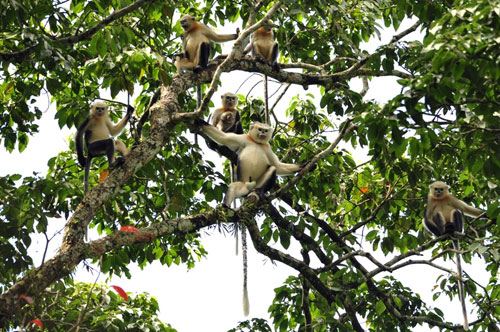The large snub-nosed monkeys are found in Ha Giang
About 113 Tonkin snub-nosed monkeys in a habitat conservation area in Ha Giang, this is the largest number ever recorded by conservationists.
The management board of Khau Ca Species and Habitat Conservation Area said about 108 to 113 animals were recorded in this area, previously only about 90 children.
The survey was carried out by Mr. Nguyen Van Truong, staff of the International Wildlife Conservation Organization (FFI), conducted with the support of the local community conservation group and the research support team of University of Colorado, Boulder.

The langurs in Khau Ca Conservation and Habitat, Ha Giang.(Photo: FFI)
The upturned nasopharynx occurs only in isolated forests in northern Vietnam. The number of this species in the world is only about 200-250 and is in danger of extinction due to hunting and habitat loss, although they are protected by law. Khau Ca species and habitat conservation area has the largest population of this species - about half of the world's species.
Mr. Hoang Van Tue, the leader of the conservation team of Ha Giang Provincial FPD said that the management board is happy to receive the above information. Dr. Benjamin Rawson, FFI Manager of Southeast Asia, Myanmar and China, congratulated the survey participants."Up to now, this is one of the few endangered species in Vietnam showing signs of recovery. This shows that with the commitment of local authorities and the participation of the community, the situation of declining pants Wildlife could be recovered, " said Dr. Benjamin Rawson.
According to Jake Brunner of the International Conservation Union (IUCN), the above information shows the importance of Khau Ca when there are about half of the upturned snub-nosed monkeys in the world."The next step, Ha Giang province should invest more financial resources to protect this population is sustainable," Jaka Brunner said.
FFI also pledged to support the conservation of the langur species.
The Tonkin snub-nosed monkey has the scientific name Rhinopithecus avunculus. They have dark brown fur. The hair on the head and the face are pale. They have no crest on the top of the head. Chest area, abdomen, front face and posterior limbs are translucent white. This white hair plate pulls the beam out of the elbow. Tail is longer than body, hairy. The new baby langur lays light yellow feathers, when it turns color like adult langurs.
- Detecting rare and precious snub-nosed monkeys in Ha Giang
- 'Make home' for ... snub-nosed monkey
- Monkeys beams 'stuffy nose' strange
- Protection of the Tonkin snub-nosed monkeys in Ha Giang
- Protecting populations of Tonkin snub-nosed monkeys in Ha Giang
- The primates are full of roses every mating season
- Discover 10 new species of creatures
- The first picture of the extremely rare upturned nose-nosed monkey
- Strangely the monkey has a long nose and mimics like a cow
- Animals need to meet before they disappear
- Biological Museum in Chinese university
- Seagrass is found in Kien Giang waters
 Animal 'suffering' after hibernation
Animal 'suffering' after hibernation Why do goats climb well?
Why do goats climb well? Scientists were surprised to see chimpanzees eating turtles
Scientists were surprised to see chimpanzees eating turtles Giant catfish died deadly due to drought in Thailand
Giant catfish died deadly due to drought in Thailand